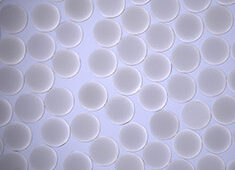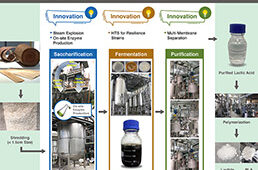Researchers
at CNRS and Université Paris-Sud 11 (1) have succeeded in creating a
conductive layer on the surface of strontium titanate (SrTiO3), a
transparent insulating material considered to be very promising for the
development of future microelectronics applications. Two nanometers
thick, this conductive layer is a two-dimensional metallic electron gas
(2DEG) that is part of the insulating material. Easy to produce, it
opens new possibilities for electronics based on transition metal oxides
(the SrTiO3 family), taking advantage of these materials’ vast range of
physical properties (superconductivity, magnetism, thermoelectricity,
etc.) to integrate a number of different functions in a single
microelectronic device. A paper explaining this unexpected discovery,
arising from research at the SOLEIL synchrotron, was published in the
January 13, 2011 issue of Nature magazine.
Today’s
microelectronic components consist of layers of semiconductors on a
silicon substrate. In order to sustain the pace of periodic upgrades in
the performance of microelectronic devices beyond 2020, alternative
technological solutions are being investigated. Researchers are
increasingly turning their attention to transition metal oxides , which
offer promising physical properties such as superconductivity (2),
magnetoresistance (3), thermoelectricity (4), multiferroicity (5) and
photocatalytic capacity (6).
Within
this family of materials, strontium titanate (SrTiO3) has been the
subject of extensive research. This insulating material becomes a good
conductor when it is doped, for example by creating a few surface oxygen
vacancies. The interfaces between SrTiO3 and other oxides (LaTiO3 or
LaAlO3) are conductive, even though the two materials are insulators.
Moreover, they offer properties like superconductivity,
magnetoresistance and thermoelectricity, with very good performances at
room temperature. The problem, however, is that interfaces between
oxides are very difficult to produce.
Now
an unexpected discovery has burst through this technological barrier.
An international team led by researchers at CNRS and Université
Paris-Sud 11 has produced a two-dimensional metallic electron gas (2DEG)
on the surface of SrTiO3. This conductive layer, approximately two
nanometers thick, was obtained by vacuum-cleaving a piece of strontium
titanate, a very simple and economical process. The constituent elements
of SrTiO3 are natural resources available in large quantities, and the
compound is non-toxic, unlike the materials most widely used in
microelectronics today (bismuth tellurides). In addition, 2DEGs could
probably be created on the surface of other transition metal oxides
using a similar technique.
The
discovery of a conductive layer of this type (not requiring the
addition of a layer of another material) is a significant step forward
for oxide-based microelectronics. It could make it possible to combine
the intrinsic multifunctional properties of transition metal oxides with
those of the two-dimensional metal on their surface. Possible
developments could include the coupling of a ferroelectric oxide with
the electron gas on its surface to produce non-volatile memories, or the
inclusion of transparent circuits on the surface of solar cells or
touch screens.
The
2DEG on the surface of strontium titanate was identified and studied in
experiments using angle-resolved photoemission spectroscopy (ARPES) at
the SOLEIL synchrotron in Saint-Aubin, France, and the Synchrotron
Radiation Center at the University of Wisconsin, USA.
Notes:
(1)
The project was carried out by researchers at the CSNSM (Centre de
Spectrométrie Nucléaire et Spectrométrie de Masse, Center for Nuclear
Spectrometry and Mass Spectrometry, Université Paris-Sud 11/CNRS) in
close collaboration with the Laboratoire de Physique des Solides (Solid
Physics Laboratory, Université Paris-Sud 11/CNRS), the CNRS/Thales Unité
Mixte de Physique (Mixed Physics Unit) and the Institut d’Electronique
Fondamentale (Fundamental Electronics Institute, Université Paris-Sud
11/CNRS).
(2) Copper, titanium, manganese, iron, cobalt, nickel, etc.
(3) The capacity to conduct electrical current with no loss of energy.
(4)
Resistance change of several orders of magnitude under the effect of a
very weak magnetic field; used in computer hard disks and USB keys.
(5)
The capacity to transform a temperature gradient into electrical power,
which could be used, for example, to capture the heat emitted by a
computer and cycle it back into the system as electrical energy (thus
using less power from the battery or mains supply).
(6) Coexistence of ferroelectricity, ferromagnetism and/or ferroelasticity, characteristic of certain iron or manganese oxides.
(7)
Characteristic of certain titanium oxides, which can even induce
hydrolysis (the breakdown of water into hydrogen and oxygen) in the
presence of ultraviolet light.
Two-dimensional electron gas with universal subbands at the surface of SrTiO3, A. F. Santander-Syro, O. Copie, T. Kondo et al., Nature, 13 January 2011.




